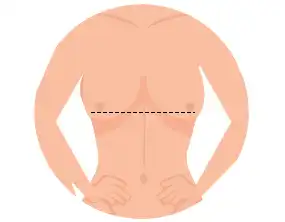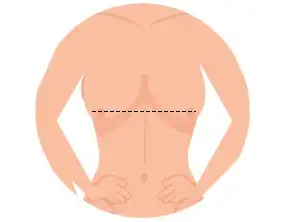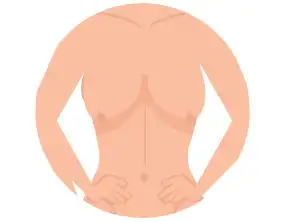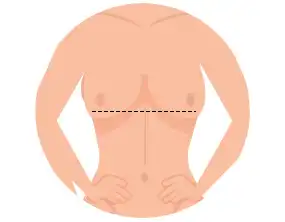Breast Sagging: Meaning, Types, Causes, Symptoms, Treatment & Cost
Breast sagging is a common condition among women. It is also called breast ptosis. There are various changes that take place in the body as a woman ages. The breast also changes over time. The skin becomes less elastic and cannot hold the weight of the breast tissues firmly, leading to sagging of the breast. Breasts are present in the lower part of the chest. Breast sagging can be measured according to the position of the nipples relative to the fold of the breast. The inflammatory fold (IMF) of the breast is the support that defines the appropriate shape and structure of the breast.

WHAT IS BREAST SAGGING
Breast sagging is the loosening of the skin of the breast as the fatty tissues become heavier. The condition is less likely to occur in small-sized breasts. It is a natural and common occurrence that happens as women age. It is characterized by the downward displacement of breast tissue, resulting in a less firm and less lifted appearance.
Breast sagging occurs when the ligaments and skin that support the breast become stretched, and the breast tissue loses its elasticity.

TYPES
Minor or 1st-degree breast sagging
Nipples located at the inflammatory fold (IMF)
1

Moderate 2nd-degree breast sagging
Nipples are located below the IMF
2

Severe or 3rd-degree ptosis
Nipples present below IMF and even below the breast contour
3

Glandular ptosis
Nipples located above IMF but breast tissue hangs below IMF
4

Pseudoptosis
Nipples located above IMF, but loose skin of breast hangs below due to hypoplasia
5

CAUSES
- Age
- Pregnancy
- Hormonal changes
- Weight gain
- Weight loss
- High BMI (Body Mass Index)
- The larger cup size of the bra
- Smoking
- Sunburn
SYMPTOMS
- Nipple pointing downwards
- A noticeable shift of the entire breast towards the lower chest
- A decline in the fullness of breasts from the top

DIAGNOSIS
Diagnosis of bresat sagging is done via physical examination. In addition to this, saggy breasts or ptosis is diagnosed using the ptosis scale also. The scale assess the degree of sagging by measuring the position of the nipple in relation to the breast crease, as well as the degree of skin laxity.
Women with breast ptosis may also be advised to undergo a breast cancer screening to ensure that the sagging is not related to breast cancer.
DO's
DONT's
TREATMENTS
NON SURGICAL TREATMENTS

Breast support garments: Wearing a supportive bra or other garment can help lift and support the breasts, providing temporary relief from sagging.
Exercises: Some exercises, such as chest presses, push-ups, and dumbbell flys, can help strengthen the chest muscles and improve the appearance of sagging breasts.
Topical creams and lotions: There are some creams and lotions that claim to improve skin elasticity and reduce the appearance of sagging, but their effectiveness is not well-established.
SURGICAL TREATMENT

Breast lift (mastopexy): This surgery involves removing excess skin and tissue and lifting the remaining breast tissue to a higher position on the chest. It can be done with or without implants, depending on the patient's goals and preferences.
Breast reduction: In cases where sagging is accompanied by large, heavy breasts that cause discomfort or health problems, breast reduction surgery may be recommended. This procedure involves removing excess breast tissue and skin to create a smaller, more lifted breast.
Breast augmentation: If sagging is accompanied by a loss of volume in the breasts, breast augmentation with implants or fat transfer can help restore a more youthful, lifted appearance.
It's important to discuss the benefits and risks of each treatment option with a qualified plastic surgeon to determine which approach is best for your individual needs and goals.
RISKS AND COMPLICATIONS
Risk factors associated with breast sagging:
- Large breast
- Obesity
- Multiple pregnancies
- Excessive coffee intake
- Stress
- Smoking
Large saggy breast lead to complications like:
- Intense pain
- Stretching
- Mastalgia (tender breast)

IF LEFT UNTREATED
If the breast sagging is not treated, it does not cause major health problems. But there can be issues with lowered self-confidence and a decline in quality of life. Excessively large breasts, if left untreated, may cause painful sensations while walking or moving around.
COST
Breast sagging is treated with breast implants or breast lift surgery. The cost of breast implants ranges between ₹ 60,000 to ₹80,000.
Financial Options

INSURANCE COVERAGE
In many cases, breast sagging is a cosmetic concern, and therefore not covered by insurance. However, if the sagging is causing significant discomfort or functional problems such as back pain or skin irritation, it may be considered a medical necessity and covered by insurance.
It's important to check with your insurance provider to understand the terms and conditions of your policy regarding breast sagging treatment. You may need to provide documentation from a qualified medical professional to support your claim that the treatment is medically necessary.
If you're considering a breast lift or reduction surgery to address breast sagging, it's also important to verify if your insurance provider will cover the procedure and what portion of the cost will be covered. Many insurance providers have specific criteria for determining whether breast reduction or lift surgery is medically necessary, so it's best to discuss your options with your insurance provider and a qualified plastic surgeon.

Know more about breast sagging
Breast sagging or breast ptosis, is a common concern among women, particularly as they age. The condition is characterized by a drooping of the breasts, which can occur due to various factors, including pregnancy, weight fluctuations, genetics, and aging.
Glamyo Health is a healthcare brand operating in the fields of elective and cosmetic surgeries, with a chain of hospitals and clinics operating in 40+ cities all over India.
If you are looking for effective treatment for sagging breast then consult Glamyo Health. They provide the best and safest breast lift surgery. Know the best Gynecologist and surgeons in Delhi and Gynecology clinics. Read about the Advanced surgical options available for effective and safe breast lift surgery. We provide you with our happy patient reviews to know their journey throughout the treatment. Breast sagging occurs when the ligaments and skin that support the breast become stretched, and the breast tissue loses its elasticity. Some of the factors that contribute to breast sagging include:
- Age: As women age, their skin loses its elasticity and collagen, which can cause breasts to sag.
- Pregnancy and breastfeeding: During pregnancy and breastfeeding, the breasts enlarge and then shrink back down, which can stretch out the ligaments that support the breast tissue and lead to sagging.
- Genetics: Some women are more predisposed to breast sagging due to genetic factors.
- Weight fluctuations: Rapid weight loss or gain can cause the skin to stretch, which can lead to sagging breasts.
- Smoking: Smoking can cause the skin to lose elasticity, which can contribute to breast sagging.
Some tips for preventing or reducing breast sagging include:
- Maintaining a healthy weight and avoiding rapid weight loss or gain.
- Wearing a supportive bra that fits properly.
- Doing chest exercises, such as push-ups and chest presses, to help strengthen the muscles that support the breasts.
- Protecting the skin from the sun prevents damage that can lead to sagging.
- Quitting smoking to help preserve skin elasticity.
If breast sagging is causing significant discomfort or self-consciousness, there are surgical options such as breast lift or breast reduction that can help improve the appearance of sagging breasts. However, it's important to talk to a qualified plastic surgeon to discuss the risks and benefits of these procedures. You can contact Glamyo Health to discuss your goals with qualified doctors at the comfort of your home or you can take an in-person appointment with the doctor.
 New Delhi
New Delhi  Bangalore
Bangalore  Mumbai
Mumbai  Hyderabad
Hyderabad  Pune
Pune  Chennai
Chennai 
